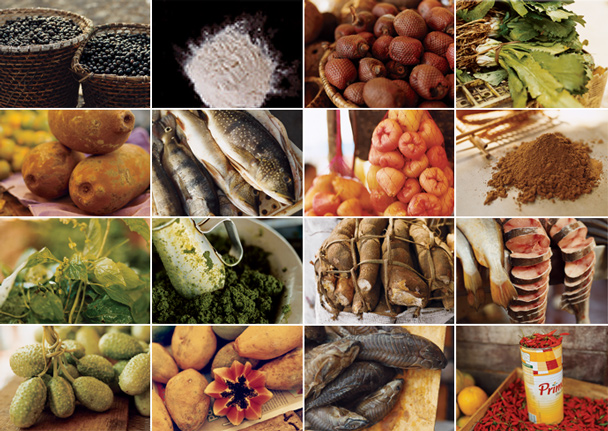- Açaí
- The iron-rich fruit of the açaí palm, native to the Amazon. Used in desserts and as an accompaniment to grilled fish.
- Alfavaca
- A highly pungent, basil-like plant with small leaves.
- Bacuri
- A thick-skinned fruit, golden yellow in color, with a viscous, pleasantly tart white flesh.
- Buriti
- A fruit with a dark scaly skin, used in drinks, desserts, and ice creams.
- Chicória
- The leaves of this plant, a relative of chicory, are used as a kitchen herb.
- Cupuaçu
- The king of the jungle fruits, this large, melon-shaped, dusty-brown fruit is a sister of Theobroma cacao, which gives us chocolate. Its flesh is wonderfully sweet and aromatic.
- Guarana
- A small tree whose orange-red fruit has become popular worldwide in the form of an energy drink.
- Jambu
- Spilanthes oleracea, known in English as “Pará cress,” “toothache plant,” or “electric cress”; this semiwild vegetable is an essential element of Amazonian cuisine. The substance that causes its numbing effect in the mouth is spilanthol.
- Maniçoba
- A popular paraense dish in which the leaves of the manioc plant are crushed and simmered for seven days (to remove poisonous hydrocyanic acid) and then cooked with bacon, sausage and other types of smoked pork.
- Maracujá
- The Amazonian name for passion fruit; native to Brazil.
- Pirarucu
- A giant freshwater fish often sold in dried form and known as the “salt cod of Brazil,” this is the main ingredient of the dish pirarucu de casaca.
- Pupunha
- A palm fruit with a fibrous yellow flesh that is generally eaten cooked rather than raw.
- Tacacá
- A Pará dish of tucupi, jambu, dried prawns, and tapioca gum that is popular in Belém and Manaus. By tradition, tacacá is sold in the streets by specialist tacacazeiras.
- Tambaqui
- An Amazonian fish that feeds mainly on fruit and seeds that fall into the river. Its ribs are often barbecued.
- Tamuata
- A freshwater fish with a distinctive armored exterior.
- Tapioca
- The starch grains obtained from the manioc root, sold either in granular form or as flour (farinha de tapioca).
- Tucunaré
- The peacock bass; a large species that is equally prized by anglers and cooks.
- Tucupi
- The yellow liquid extracted from the manioc root as a by-product of flour manufacture. Toxic when raw, it is boiled to remove hydrocyanic acid. Seasoned with salt, alfavaca, and chicória, it is much used in local cooking.
In northern Brazil, the mighty Amazon River defines a landscape rich in ingredients that most of us have never even seen before. But Brazil's vibrant cuisine is on the move—and açaí was just the first wave. So keep your ears, eyes, and mouth open and get to know and enjoy the Amazonian ingredients below. This glossary originally accompanied Jungle Fever in Gourmet magazine, November 2006.
By Paul Richardson
By Paul Richardson

Selected foods of the Amazon, left to right from top: Açaí berries; tapioca flour; buriti; chicória. Second row: Cupuaçu; tucunaré; pink jambo melon; guarana powder. Third row: Jambu ("electric cress"); manioc leaves; manioc root; fish steaks at Mercado Ver-o-Peso. Fourth row: Maxixe (small gherkin); papaya; tamuata; local chiles.
